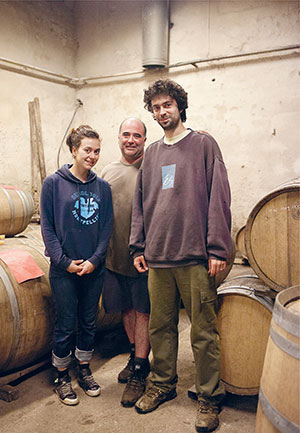
Natural reds show aroma profiles that are not as radically different from those of their conventional counterparts, as is the case with white and orange wines. The main reason for this is that still, conventional reds are generally made more naturally than any other wine color or style (with the exception of added yeasts, which still remains the norm). This is because, as with natural reds, the juice is left to stew on the skins (and/or pips and stems), so that the color leaches out. With it come tannins and antioxidants that help protect the wine from oxygen. As a result, conventional growers tend to add fewer sulfites to their red wines than they would to their white wines. Even the legal EU limits for the total amount of sulfites allowed in wine are lower for reds than for whites.
Having said that, there is a distinctive naturalness to the wines, which you will definitely be able to taste. Firstly, you rarely find natural wines caked in aromas of new oak, especially not deliberately. Finding good-quality old barrels can be tricky, however, and, more often than not, producers end up having to buy new barrels that they then season themselves. This means that their first few vintages can show more oak notes and coarser tannins. But, apart from this practical measure, natural producers tend to shy away from oakiness, as they see it as a distraction from the purity of their grapes and terroir. In La Renaissance des Appellation’s charter of quality, for example, 200% new oak—that is, using two new oak barrels during winemaking, which certain conventional wine producers take pride in doing—is forbidden.
Equally, the berries of natural growers tend to be harvested at full phenolic ripeness, but without leaving them to hang in the vineyard for the sake of building up jammy notes, as can be the fashion. Since there is no recourse to rectifying acid, growers have to make sure their grapes naturally retain enough to obtain a good natural balance.
It is also becoming increasingly popular among natural growers to return to the traditional method of fermenting with whole bunches of grapes (i.e. to ferment everything together rather than de-stemming the grapes first). If the stems are perfectly ripe, this adds extra complexity of texture, freshness, and floral notes that are almost violet-like. Antony Tortul, one of whose wines is featured in this selection and who makes a crazily diverse, fantastic range of wines without any additives, is a grower who uses this method. In fact, he does not use any temperature control, even in the height of summer. Indeed, I loved his simple, matter-of-fact reasoning when he explained to me that his wines, “Come from the South of France, where grapes see 35°C for three months of the year. This means that, by harvest, they have learned to withstand the heat. They are used to it. Some wines go up to 30°C during fermentation, but it does not worry me. The last thing I want is to make wines that taste of the vinification, because I try so hard to express the terroir in all my cuvées.”
Finally, there’s the drinkability and moreishness. This is, for growers, at the core of their natural-wine production, and is particularly obvious if you compare natural and conventional reds. Even if the wines are complex and intense, good natural red wines will always show immense freshness and digestibility, no matter how youthful or mature they are—and this is what makes them so compelling.

The talented Antony Tortul, and team, in their cellar outside Béziers.
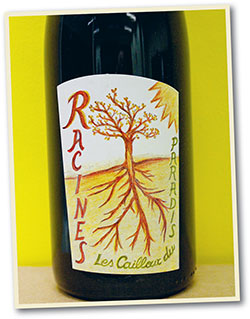
Natural wines are such a reflection of their environment that they inevitably become more complex as the diversity of life forms around the vines expands. Twenty or so years ago Claude Courtois, in the Loire, France, noticed such a difference on one plot that it prompted him to create a brand new cuvée—Racines.
A few of Antony Tortul’s multitudinous cuvées.
 FRENCH LIGHT-BODIED REDS
FRENCH LIGHT-BODIED REDS
Domaine Cousin-Leduc, Le Cousin, Le Grolle
Loire
Grolleau gris, grolleau noir
Peppery | Poppy | Curry leaf
Olivier Cousin, a keen sailor and legendary horseman, is perhaps natural wine’s most lionized wild child. Having publicly fought the appellation system for many years (see Who: The Artisans, pages 100–105) and been uncompromisingly natural with his farming and vinification methods, he has inspired many young growers to opt for this way of life. Probably the wine world’s most outspoken advocate of solidarity, Olivier is the ultimate bon vivant. With his focus on clean farming and producing easy-drinking wines for consumption in large quantities (as his email signature says: “Save on energy and preserve the environment: uncork less, drink magnums!”), coupled with his commitment to community and cooperation, Olivier has, over the years, developed a bit of a cult following, with fans from as far away as Japan returning every year to visit or help.
Fragrant and with a lovely soft tannic grain, this easy, round wine is the perfect way to celebrate the arrival of spring. Drink within a day of opening.
*No added sulfites
Patrick Corbineau, Beaulieu
Chinon, Loire
Cabernet franc
Fragrant cassis | White pepper | Mace
A lovely, sensitive man, Patrick Corbineau makes gentle wines that are also powerhouses in terms of complexity and their ability to age. Tense and delicious, this chinon, which spent two years in barrel, is an incredibly beautiful wine. Patrick’s production is tiny and his wines tricky to get hold of, but they are very rewarding if you manage to track them down. Still incredibly young.
*No added sulfites
Pierre Frick, Pinot Noir, Rot-Murlé
Alsace
Pinot noir
Orange peel | Violets | Cumin
Jean-Pierre Frick manages his domaine (of a dozen, mainly chalky, plots) with his wife, Chantal, and son Thomas. A pioneer of biodynamics in Alsace, Jean-Pierre converted his estate in 1981, after having already worked his vines organically since 1970. This 100-year-old pinot noir, from a limestone parcel rich in iron (hence its name, rot-murlé, meaning “red-walled”), looks pale and light, yet is incredibly fragrant, detailed, and long on the finish.
*No added sulfites
 FRENCH MEDIUM-BODIED REDS
FRENCH MEDIUM-BODIED REDS
François Dhumes, Minette
Auvergne
Gamay
Sweetpea | Stony minerality | Mulberry
Inspired by the low-intervention producers of his native Auvergne, including Vincent Tricot (see White Wines, page 150), Patrick Bouju, and Stephane Majeune, François Dhumes decided to turn his back on the more industrial teachings of his winemaking school in Burgundy, as well as five years working conventionally in the Rhône. He farms 7 acres (3 hectares) of gamay d’Auvergne and chardonnay on basalt/red clay/limestone soils. The Minette has a surprisingly firm, but fine, structure and a bitey minerality, as well as being very scented. A dash of volatile acidity, but nicely integrated.
*No added sulfites
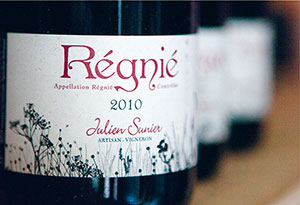
This Beaujolais by Julien Sunier is another mid-bodied natural red.
Loire
Cabernet franc
Plum | Spring flowers | Green coffee bean
Sébastien’s family has been making wine in the Loire region for some eight generations. Working with some of the family vines, the wines have a beautiful place—525ft (160m) of cellars, dating back to 1637, that were dug by hand beneath his home—in which to mature slowly.
Sébastien cultivates 14 acres (6 hectares) of cabernet franc and 2½ acres (1 hectare) of chenin blanc in Saumur-Champigny, with the help of his partner, a former dancer turned vigneronne, Emeline Calvez. The Hanami is juicy and fresh. It is usually made without sulfites, although this can vary from vintage to vintage, as some of their cuvées have low levels added at bottling.
*No added sulfites
Christian Ducroux, Exspectatia
Beaujolais
Gamay
Bilberry | Matcha tea | Alfafa flower
Christian Ducroux is a farmer who is committed to the living above all else. His 12 acres (5 hectares) of vineyard, with its pink granite soil, is a hub of biodiversity: fruit trees alternate with each five rows of vines, hedges surround the parcels, and wild grasses grow throughout. And, as he says on the bottle, “In order to help the plant on its path, [our] mares, Hevan and Malina, help us plow in ways that promote microbial life.” Exspectatia is soft and juicy to start with, gaining power as it is exposed to oxygen, when it reveals complex, earthy tones and spices, reminiscent of the forest floor. It is a very accomplished wine and anyone in any doubt that gamay is capable of long-lived greatness, or indeed anyone dubious that natural wine can combine refinement, complexity, and purity, then this is a must-taste for you.
Note: As one of the principal birthplaces of the natural-wine rhizome (see Who: The Origins of the Movement, page 116), the Beaujolais is a hotbed of great natural growers. A few other growers to look out for include Marcel Lapierre, Yvon Metras, Jean Foillard, Guy Breton, Jean-Paul Thévenet, and Joseph Chamonard—the natural wine old guard, if you like—but also a host of newish additions: Hervé Ravera, Julie Balagny, Philippe Jambon, Karim Vionnet, and Jean-Claude Lapalu, among others.
*No added sulfites
La Maison Romane, Vosne-Romanée Aux Réas
Burgundy
Pinot noir
Balsamic | Allspice | Mulberry
Oronce de Beler vinifies no less than 10 different crus in Burgundy from vines he leases from other growers. His wines are edgy, chiseled, and perfumed, and flirt with VA (volatile acidity) in a positive way. Oronce plows by horse, and he and Prosper (his plow horse) lend out their services to other growers. He also started Equivinum, a company that sells horse plows which he designed and developed with the help and know-how of a handful of other Burgundian domaines. Oronce’s reds are vinified whole bunch.
*Low levels of sulfites added
Clos Fantine, Faugères Tradition
Languedoc
Carignan, cinsault, syrah, grenache
Rosemary | Black cherry | Licorice
Owned and run by a sibling trio, Carole, Corine, and Olivier Andrieu, this 72-acre (29-hectare) farm in southern France (see Wild Salads, pages 88–89) is only planted with bush vines, which is a common practice in hot climates. This means that the plants are left to grow like spiders in tufts rather than on wires or posts. The Andrieus’ soils are dominated by schist, which is very apparent in another of their wines, Valcabrières, a tiny cuvée of pure terret with a biting minerality. Faugères Tradition, a carignan-dominated blend, is dark and juicy, with a spicy, savory edge and garrigue notes that remind you of a warm afternoon in the sunny south.
*No added sulfites
Henri Milan, Cuvée Sans Soufre
Provence
Grenache, syrah, cinsault
Spicy cherry | Violets | Damson
Located near St Rémy de Provence (made famous by Van Gogh, who spent a year in an asylum there), the family domaine was taken over in 1986 by Henri Milan, who had wanted to be a vigneron since the age of eight when he planted his first vine. After a disastrous first attempt at no-added-S02 winemaking, which wreaked financial chaos for him (see Conclusion: A Celebration of Life, pages 92–95), Henri’s butterfly range is today a hugely popular, very-easy-drinking, no-sulfite red; a bestseller in the United Kingdom. Pure and fragrant.
*No added sulfites
Les Cailloux du Paradis, Racines
Sologne, Loire
Field blend of dozens of grapes
Forest floor | Red currant | Pepper
Located in the Sologne, where Parisians come to hunt game, Claude Courtois is another natural wine hero (see Who: The Origins of the Movement, pages 114–17, and The Artisans, pages 100–105), and one of the few remaining vignerons in this area of the Loire.
This farm, with its fruit trees, woods, vines, and fields, is a model of agricultural diversity that treats soil with the respect due to any living organism. Dedicated to heritage varieties, the Courtois family even planted syrah after finding references to the variety in a 19th-century text, which told the story of a grower who made what was considered the best red wine of the Loire: a 100% syrah. They initially received the go-ahead from the local authorities, who later recanted, sued the Courtois family, and forced them to grub their vines. The Courtois’ Racines (see Discovering Natural Wine: An introduction, pages 132–35), a multi-blend of grapes, is earthy and complex, showing best after several years as its perfumed, floral side blossoms.
*Low levels of sulfites added
La Grapperie, Enchanteresse
Côteaux du Loir, Loire
Pineau d’aunis
Red peppercorn | Nasturtium | Cassis
Having started La Grapperie in 2004 with very little previous winemaking experience, Renaud Guettier is meticulous, both in the vineyard and in the cellar. His 10 acres (4 hectares) are spread over 15 micro plots, each with its own microclimate, and vinified without the use of any sulfites in the winemaking. Instead, Renaud uses the wisdom of time to stabilize his wines. Long élevages are the norm here, sometimes for as long as 60 months in barrel. The Enchanteresse is precise, elegant, and linear, and a testament to the fact that Renaud’s wines are some of the most promising in the Loire today.
*No added sulfites
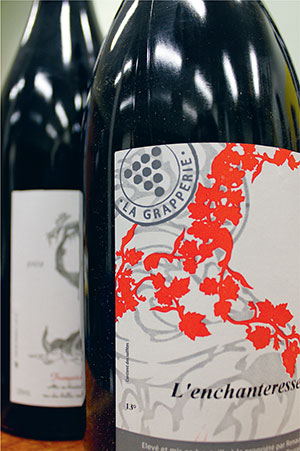
Domaine Fontedicto, Promise
Languedoc
Carignan, grenache, syrah
Black olive | Rosemary | Juicy red cherry
Bernard Bellahsen (see Horses, pages 106–107), the inspirational, self-taught, incontestable maestro of animal traction, started his agricultural adventure producing fresh grape juice before eventually moving into wine. Today, he also grows ancient varieties of wheat (some 6ft/2m tall), which he and his wife, Cécile, mill and bake into bread to sell at the local market.
Bernard’s Promise is intense and concentrated, effortlessly challenging the myth that wines without sulfites cannot be aged. A must for the cellar.
*No added sulfites
Jean-Michel Stephan, Côte Rôtie
Rhône
Syrah, viognier
Parma violet | Blood orange | Juniper
Fancy tasting a benchmark Côte Rôtie? Well, Jean-Michel Stephan’s is definitely as good as it gets. Côte Rôtie is all he makes, so the full range is worth exploring. Guided by the teachings of Jules Chauvet (see Who: The Origins of the Movement , pages 116–17), Jean-Michel has been a natural purist from the start (in 1991): all the work on his steep, organic hillside vineyards is done by hand and his winemaking is low-intervention. He mostly grows old-vine syrah, of which a large proportion is, in fact, sérine, the small-berried, low-yielding local variation of syrah, which is experiencing a resurgence, thanks to the work of a handful of growers, including Jean-Michel.
Although not one of Jean-Michel’s famed sérines, this bottle is a classic Côte Rôtie blend. It’s an expressive, perfumed, ethereal version of syrah with a heady purity, and it is, quite simply, bloody magnificent.
*No added sulfites
Château le Puy, Emilien
Côtes de Francs, Bordeaux
Merlot, cabernet sauvignon
Rich plum | Cedar | Cocoa bean
Located on the same rocky plateau as Saint-Emilion and Pomerol, Château le Puy is a rarity in Bordeaux. “One of my grandfathers was too miserly, and the other too much of a visionary, ever to use synthetic chemicals in the vineyard,” jokes Jean-Pierre Amoreau, when asked how his Château has managed to farm organically for the last 400 years.
Having shot to fame after their 2003 vintage was featured in the Japanese manga comic The Drops of God, the domaine achieved cult status almost overnight. And deservedly so. Le Puy wines are elegant, traditional clarets, which even the most classic of drinkers will enjoy. This 85% merlot is from a ripe year, which brings an added generosity and plushness to what is already an approachable, yet age-worthy, wine.
*Low levels of sulfites added
La Sorga, En Rouge et Noir
Languedoc
Grenache noir, grenache blanc
Violet | White pepper | Bilberry
With his laid-back manner and wild, gregarious curls, you’d never guess that Antony Tortul, a trained chemist, is actually über-meticulous by nature (see Who: The Artisans, pages 100–105).
This young négociant-winemaker in the Languedoc, who started producing in 2008, works with 40 different types of vine, including many heritage varieties, such as aramon, terret bourret, aubun, carignan, cinsault, and mauzac, among others. “I always wanted to produce lots of small batches of pure wines of terroir with non-interventionist vinifications,” says Antony.
Antony’s En Rouge et Noir is ethereal, perfumed, and moreish—a superbly pleasurable drinking wine. Definitely a grower to watch.
*No added sulfites
 ITALIAN LIGHT-BODIED REDS
ITALIAN LIGHT-BODIED REDS
Cascina Tavijn, G Punk
Asti, Piedmont
Grignolino
Red currant | Cherry stone | Juniper
Nadia Verrua’s family has grown and made wine on the sandy slopes of Monferrato for over a century. Her 12 acres (5 hectares) are home to hazelnuts and indigenous, old-vine grape varieties, including barbera, ruché, and grignolino. The latter gives us G Punk, a wild, bright, tannic (fine) wine with a touch of salinity that also shows a vivid cherry-stone bitterness, which is seemingly characteristic of this ancient Monferrato grape variety. It is thought that “grignolino” is, in fact, derived from the Asti dialect for “many pips” (or grignole), which could be the source of some of the bitterness. A deliciously drinkable wine.
*No added sulfites
 ITALIAN MEDIUM-BODIED REDS
ITALIAN MEDIUM-BODIED REDS
Cantine Cristiano Guttarolo, Primitivo Lamie delle Vigne
Puglia
Primitivo
Bilberry | Balsamic | Lime
People usually think of primitivos (better known in the United States as zinfandel) as huge, gushing wines (which they certainly can be), but Guttarolo’s is all about freshness and acidity. Made in a stainless-steel tank, this floral, linear wine is also wonderfully mature and savory.
Located near Gioia del Colle, on Italy’s heel, Cristiano also makes an anfora primitivo, which, while tricky to track down, is really worth the effort. It is an amazing wine.
*No added sulfites
Lamoresca, Rosso
Sicily
Nero d’avola, frappato, grenache
Mulberry | Violet | Cinnamon
Named after the ancient local “moresca” olives, the Lamoresca estate boasts 1,000 olive trees of its own alongside 10 acres (4 hectares) of vines. Filippo Rizzo pioneered wine production in this area with great results. This blend of nero d’avola (60%), frappato (30%), and grenache (10%) is bursting with bright red fruits.
*Low levels of sulfites added
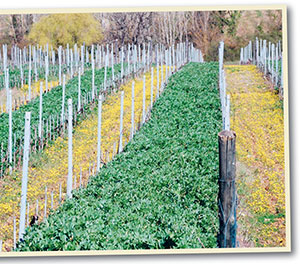
Montesecondo’s vines in spring, showing the use this vineyard makes of cover crops.
Aosta Valley
Nebbiolo
Balsamic | Cherry bark | Blackberry
Old-fashioned and rustic, this nebbiolo comes from the smallest, least populous region of Italy, the Aosta Valley in the Alps. Created thousands of years ago during the last Ice Age, this region is the home of mighty peaks, including the Matterhorn, Mont Blanc, and Monte Rosa, and also to Jean Louis Nicco’s terraced vineyard. “We have one of the best terroir in the world!” he exclaims. Bought in 1948 by Jean Louis’ grandfather, who decided to produce natural wine to sell on tap to his fellow villagers, it was then taken over by his mountaineer father, Rinaldo, in 2001, and is now in Jean Louis’ hands.
Picotendro (meaning “nebbiolo” in Aostan) is a powerful wine with distinct tannins and a lot of concentration, with marked signs of having spent time in old oak. Long-ageing, the wine has a supple resilience that ages really well (I tasted various older vintages simultaneously).
*No added sulfites
Cascina degli Ulivi, Nibiô, Terre Bianche
Piedmont
Dolcetto
Morello cherry | Black olive | Gamey
Stefano Bellotti’s farm is a model of sustainability. With its 54 acres (22 hectares) of vineyards, 25 acres (10 hectares) of arable land (rotated between wheat and fodder), 2½ acres (1 hectare) of vegetable gardens, 1,000 fruit trees, herd of cattle, and collection of other farmyard animals, Stefano has farmed organically since the 1970s and biodynamically since 1984. Made from dolcetto grapes (called nibiô in the local dialect), which have red stems, this wine is an ancient tradition of the Tassarolo and Gavi regions, with the grape variety having been grown in these parts for more than 1,000 years. With its nicely developed nose, touch of gameyness, and complexing volatility (VA), the tannins are completely integrated into the wine and the result is seamless. Perfectly mature now.
*No added sulfites
Panevino, Pikadé
Sardinia
Monica, carignano
Mulberry | Capers | Peppermint
Gianfranco Manca inherited a bakery with its own set of old vines of 30 different grape varieties. And so was born the name panevino (“bread wine” in Italian). Thanks to his understanding of breadmaking (and the fermentation this involves), working with grapes was a natural progression. Dense and savory, and completely closed to start with, this quaffable wine opened with dark cherry notes that morphed into more floral, redder ones.
*No added sulfites
Montesecondo, TÏN
Tuscany
Sangiovese
Black cherry | Cacao | Orris
Saxophonist Silvio Messana spent years living in NYC, before returning to his family’s Tuscan estate on the death of his father (a jazz-musician-turned-wine producer who’d planted the vineyard in the 1970s). At the time, his mother was selling their grapes in bulk, but Silvio dived headfirst into the challenge, bottling his first vintage in 2000.
Nowadays, as Silvio explains, “We think of the winery as a living organism” and the work of winemaking as “a natural transformation.” His wines are, indeed, a testament to his philosophy. Named for the Arabic for “clay,” Tïn—which was made in a 100-gallon (450-liter) Spanish, clay amphora—spent 10 months on its skins and was bottled unfiltered. The result is very floral and elegant.
Did you know? Although Tuscany may not seem synonymous with wilderness, Montesecondo is so remote, you can actually hear wolves howling at night!
*Low levels of sulfites added
Cornelissen, Rosso del Contadino 9
Sicily
Nerello mascalese and a dozen or so other local white and red grapes
Wild strawberry | Hyacinth | Pomegranate
Having started his career as a Belgian wine merchant, Frank Cornelissen searched high and low for his perfect terroir, ending up on the slopes of the unpredictable Mount Etna, a location that epitomizes his own farming philosophy: “Man can never understand nature’s full complexity and interactions.” Frank avoids all interventions on the land, choosing to follow nature’s clues rather than assert himself over it. He avoids all treatments, “whether chemical, organic, or biodynamic, as these are all a reflection of man’s inability to accept nature as she is and will be.” The Rosso del Contadino 9 is simultaneously extremely fun and very serious. Try it to understand.
*No added sulfites
Il Cancelliere, Nero Né
Taurasi, Campania
Aglianico
Cassis | Floral | Cranberry vibrancy
Being situated at an altitude of 1,800ft (550m) makes all the difference when you’re growing in the Mediterranean’s warmer climes. The slight elevation means day and night temperature differences that help lengthen the ripening season, producing generally cooler, less baked wines. Aged for two years in big botti, and then for another two years in bottle, the long maturation helps tame aglianico’s big, firm structure. The whys-and-wherefores of this process are based on the “peasant art,” as vineyard owner Soccorso Romano calls it, of making wine that he learned from his dad.
*Low levels of sulfites added
Case Corini, Centin
Piedmont
Nebbiolo
Rose petal | Wild thyme | Morello cherry
The first time I tasted Centin, a few years back, I was taken aback by its sublimity. It is, quite honestly, the perfect expression of nebbiolo—a wine with poise, charisma, generosity, and gentleness all at once. A wine, in fact, very much like its creator, Lorenzo.
Lorenzo Corino combines theoretical knowledge (having spent most of his working life researching in the field of agriculture—cereals, viticulture, and winemaking) with practical experience, being the fifth generation of a grower-maker family in Costigliole d’Asti, in Piedmont. He is also an advisor to biodynamic farm La Maliosa (see Orange Wines, page 167) in Tuscany. He is an extraordinary man, with a depth of knowledge and a willingness and generosity to share it that is remarkable. After authoring and co-authoring more than 90 technical and scientific publications on viticulture, Lorenzo finally penned his first book—a memoir entitled Vineyards, Wine, Life: My Natural Thoughts (published in the spring of 2016) that gathers together all his invaluable experience.
*No added sulfites
Podere Pradarolo, Velius Asciutto
Emilia-Romagna
Barbera
Kirsch | Cloves | Balsamic
Podere Pradarolo produces uncompromising wines in the Parma Hills, in Emilia-Romagna. The grapes are fermented without temperature control and with prolonged macerations of 30 days to nine-plus months, regardless of grape color. This barbera spent 90 days on its skins and then 15 months ageing in large oak casks before bottling. A savory, moreish wine.
*No added sulfites
 REST OF EUROPE MEDIUM-BODIED REDS
REST OF EUROPE MEDIUM-BODIED REDS
Bodega Cauzón, Cabrónicus
Granada, Spain
Tempranillo
Blueberry | Pomegranate | Licorice
Made using carbonic maceration, this tempranillo is grown at altitude (Cauzón’s vineyards are located at an altitude of 3,500–4,000ft/1,080–1,200m in the Sierra Nevada), where extreme temperatures and slow ripening have a marked effect on the vivacity of color, acidity, alcohol, and tannins of the wine. The vineyard is owned by Ramón Saavedra, a chef from the Michelin-starred restaurant Big Rock, on the Costa Brava. Ramón decided to abandon the kitchen and return home to learn how to grow and make wine. Today, Bodega Cauzón is part of a healthy cohort of natural vignerons populating the mountains around Granada. Cabrónicus is the lightest and juiciest of its cuvées.
*No added sulfites
Mendall, Finca Espartal BP
Terra Alta, Spain
Garnacha
Red cherry | Iris | Almost bloody
One of my everyday favorites at the moment, this wine is so easy to drink that you just can’t stop, or, as Laureano Serres (its creator) jokes, “It must be like a chuche, a ‘lollipop.’” This spirited, highly individual Catalan produces some dozen or more wines in the Terra Alta, 124 miles (200km) south of Barcelona and 31 miles (50km) inland. Only about 1,000 bottles of each are produced yearly (in fact, some cuvées number only a few hundred bottles), and, having recently tasted my way through his 2013s, I can safely say: drink the lot; they are bloody brilliant.
*No added sulfites
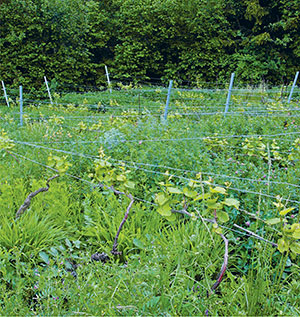
Spot the vines! Mythopia’s living garden in full swing.
Mythopia, Primogenitur
Valais, Switzerland
Pinot noir
Raspberry | Violet | Crunchy red currant
With views of some of the highest summits of the Alps, the steep slopes of Mythopia are a paradisiacal vine garden (see A Living Garden, pages 30–31) of wild flowers, fruit trees, leguminous plants, grains, rare birds, green lizards, and more than 60 species of butterfly. Using agricultural practices derived, at least in part, from ancient methods used by the Aztecs, Mythopia is an ecosystem sustained by a rich, symbiotic network of thousands of species of creature. Primogenitur is, as Mythopia’s owner, Hans-Peter Schmidt, himself describes it, a “coltish, fruity, jaunty” wine with the same upfront enthusiasm as a child who is “growing up in nature, without complexes, or deceptions. A wine that helps you to remember the best of the day.” Hear, hear: I couldn’t say it better myself.
*No added sulfites
Weingut Karl Schnabel, Blaufränkisch
Südsteiermark, Austria
Blaufränkisch
Bramble | Floral | Fresh cranberry
“Our doing is based on the principle that we are only guests on our earth,” says Karl, “and that our earth needs to be sustained for future generations.” This, to the Schnabels, means that such things as land rights or ownership only mean that a person has been given direct responsibility for a part of our shared planet. In other words, explain Karl and Eva, landowners have a duty of care to handle the land for the benefit of the common good, such as through the production of nourishing food, or as a contribution to a healthier planet.
This reserved, shy, humble couple are proud farmers, quietly going about doing really great stuff, simply because it fits with their personal convictions. They build stone piles and create watering holes, for example, to encourage reptilian life in the landscape (including smooth snakes and colubrids). A pure, mineral blaufränkisch, this wine’s vibrancy is testament to this way of life.
*No added sulfites
Terroir al Limit, Les Manyes
Priorat, Spain
Garnacha
Ripe mulberries | Slatey | Licorice
This garnacha, from 50-year-old vines grown on clay at an altitude of 2,600ft (800m), is pure and tight with dark fruit, gentle tannins, and a very precise, almost chiseled, texture. In fact, as with all Dominik Huber’s wines (see White Wines, page 156), not only is this red surprisingly delicate, an extraordinary feat given its semi-arid location and the pounding Spanish sun, but it also seems to become more and more precise with each new vintage I taste. This is almost certainly the most elegant expression of Priorat you are likely to find.
*Low levels of sulfites added
Costador Terroirs Mediterranis, La Metamorphika Sumoll Amphorae
Penedès, Spain
Sumoll
Kirsch | Damson | Rosemary
With vineyards in the foothills of the Pyrenees, some of which climb to an altitude of 3,000ft (900m), Joan Franquet grows 20 varieties of grape (from old vines, some of which are over 100 years old!). These include a host of indigenous Catalan varieties such as dark sumoll, trepat, macabeu, xarel.lo, sumoll blanc, and parellada. This sumoll is well made and considered, having spent nine months in a Spanish tinaja.
*No added sulfites
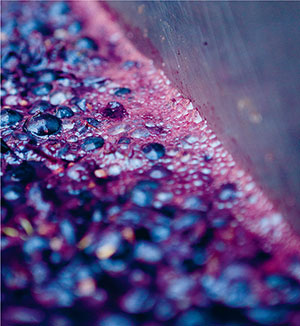
Named after the Latin fervere (meaning “to boil”), fermentation is such a noisy, lively affair that it does look like the juice is boiling.
 REST OF EUROPE FULL-BODIED REDS
REST OF EUROPE FULL-BODIED REDS
Casa Pardet, Cabaret Sauvignon
Costers del Segre, Spain
Cabernet sauvignon
Dark plum | Nasturtium | Poppy
Josep Torres started his project in 1993, farming organically from the start and then turning to biodynamics in 1999. For Josep, a living vineyard and living wines are paramount. As he says, “You can drink as many corpses of wine as your head will allow, then try natural wine, with its own life, without additives, and your body will thank you for it.”
Like Josep, this wild bomb of a wine bursts with energy and a real exuberance of fruit, while also expressing confidence and a surprising (subtle) elegance. Also keep your eyes open for his raft of exciting-sounding vinegars—each is either 10 or 15 years old, some are made in solera, others in French oak, one is macerated with rosemary, while another is mixed with honey.
*No added sulfites
Clot de Les Soleres, Anfora
Penedès, Spain
Cabernet sauvignon
Blackcurrant | Wild mint | Lily
Carles Mora Ferrer’s beautiful farm building dates back to 1880 and is located just inland from Barcelona in the Penedès. Having made his first additive-free vintage in 2008, Carles’ wines have gone from strength to strength. This bottling of cabernet sauvignon spent 13 months in anfora, which, while clearly kissed by the Mediterranean sun, also shows a clarity and purity of aromas brought about by a cooling sea breeze.
*No added sulfites
Nika Bakhia, Saperavi
Kakheti, Georgia
Saperavi
Blackberries | Rosemary | Cassis
In 2006, Georgian artist Nika Bakhia, who spends much of his time in Berlin, bought a small vineyard of saperavi and an abandoned wine cellar in Anaga, in Kakheti, which is Georgia’s largest winemaking region. His 15 acres (6 hectares) of land includes saperavi, rkatsiteli, and a small collection of tavkveri, khikhvi, and kakhuri mtsvane, which he uses for experimentation. “Winemaking is a creative process,” he explains, “like sculpting or painting; it is based on the understanding of the nature of materials and not rejecting or oppressing their original features.”
Saperavi skin is thick and its flesh tainted, always yielding intensely colored, almost black, wines—in fact, I once dyed a T-shirt in saperavi juice and it came out lilac! Nika’s Saperavi is a very intense, concentrated, tannic wine, which was vinified and matured in traditional qvevri clay pots that are buried in Nika’s cellar—a process that was officially recognized by UNESCO as part of the Intangible Heritage of Humanity in December 2013.
*Low levels of sulfites added
Barranco Oscuro, 1368, Cerro Las Monjas
Granada, Spain
Cabernet sauvignon, cabernet franc, merlot, grenache
Ripe blackberry | Cinnamon | Oak toast
Named after the altitude of the vineyard (4,500ft/1,368m above sea level), Barranco Oscuro’s vines are some of the highest in Europe. Growing in the foothills of Sierra Nevada, in Andalucia, the coolness of the location helps create wines of freshness and great acidity, while the blistering sun of southern Spain gently bakes the berries on the vine. The result is muscular wine with dark-berry fruit that is very Spanish in its opulence and ripeness, while also tighter in texture than most. Although oaky (probably the oakiest wine in this section), it has great layering and depth. Needs food on the side.
*No added sulfites
Granada, Spain
A fruit salad: syrah, cabernet sauvignon, merlot, tempranillo, cabernet franc, pinot noir, petit verdot
Rosemary | Black olive | Mulberry
Torcuato Huertas has worked the land all his life, growing mainly olives and fruit. Back then, his wine was solely for home consumption, but in the early 1980s, with the help of his mentor (and relative) Manuel Valenzuela from Barranco Oscuro (see previous page for details), his focus began to change. Today he farms some 7 acres (3 hectares), on which he grows a staggering 21 grape varieties. Being a blend of seven varieties, Tinto is not about varietal expression, but is rather a product of place. It owes its ripe fruit flavors to the southern heat and its freshness to its altitude.
*No added sulfites
Dagón Bodegas, Dagón
Utiel Requena, Spain
Bobal
Prune | Cherry liqueur | Balsamic
Dagón’s wines are directly informed by Miguel’s singular farming style, which he has developed over the course of decades. Interventions in the vineyards are minimal, with no farming aids whatsoever (including manures or even Bordeaux Mixture) having been used since 1985. Instead, Miguel stood by the logic that vines should adapt to their environment, which, in this case, is the indigenous Mediterranean flora and fauna that share their space. And adapt they did, with Miguel’s grapes believed to be among the healthiest in the world (see Health: Is Natural Wine Better For You?, pages 84–87).
Bone-dry and as uncompromising as its guardian, Miguel’s bobal was macerated on its skins for several months, pressed, and then aged in oak, where it remained for some 10 years before bottling. While not the sort of wine you’re likely to drink a whole bottle of in a single sitting, its intensity is utterly delicious. It’s more of a meditative type of wine.
*No added sulfites
Els Jelipins, Font Rubi
Penedès, Spain
Sumoll, garnacha
Black cherry | Seville orange | Dried herbs
“My story is pretty simple. I liked drinking wine, so I decided to work in it and, once that happened, all I wanted was to make my own wine. This was also, in part, because most of the wines I came across back then were very extracted and powerful, tiring wines, that you couldn’t even eat with, they were so big. So I thought, how great it would be to make a wine I actually wanted to drink. And that’s one of the reasons I love sumol,” says Glòria Garriga, who started Els Jelipins back in 2003. “At the time everyone was ripping it out, because the authorities had declared it a ‘lesser’ grape, incapable of making quality wine. In fact, it was completely prohibited for use in DO Penedès. But I loved the wines we made from it and I loved the fact that most of the remaining parcels were ancient vines, many over 100 years old and belonging to elderly people who used it only for their own consumption. So, I loved the social side of it and the idea of preserving this heritage.”
Thanks to Glòria’s work, and the wines she produced, sumol’s reputation blossomed so much that the DO started singing to a different tune, extolling the virtues of this magnificent grape, and today new plantings are going back in. Glòria’s 2009 Font Rubi, each bottle of which is individually painted with a tiny red heart, is rich and opulent, with an incisive minerality and beautiful balance, as well as a touch of volatile acidity that actually brings even more complexity to a very accomplished vintage.
*Low levels of sulfites added
 NEW WORLD MEDIUM-BODIED REDS
NEW WORLD MEDIUM-BODIED REDS
Vincent Wallard, Quatro Manos
Mendoza, Argentina
Malbec
Blueberry | Violets | Purple basil
This collaborative project gets its name from the four hands of its owners: Emile Hérédia, natural grower and owner of Domaine Montrieux in the Loire, and Vincent Wallard, a French ex-restaurateur from London. Although tricky practicalities, such as sourcing bottles and corks, meant the project was far from easy to put in place, the results are excitingly individual. A polar opposite to most Argentinian malbec, much of which can be formulaic: overripe, lacking juice, and oaky, this part-whole-bunch, part-de-stemmed—a fermentation technique known as the “sandwich method” because of the different stratas in each vat—and unoaked wine shows extra floral, almost exotic, notes, with a pepperyness and softly tannic structure that make it very moreish.
*Low levels of sulfites added
Clos Ouvert, Huasa
Maule, Chile
País
Iris | Cocoa | Sage
Given how rare single bottling país is, you would never guess that it is actually the most widely planted grape in Chile—in fact, you could easily travel the length and breadth of the country, visiting wineries, and come away never even knowing it existed. Brought over by Spanish settlers/missionaries in the mid-16th century, país was relegated to mass production after failing to match the dollar-appeal of fashionable, international grape varieties. That is until Louis-Antoine Luyt arrived on the scene. This young French natural grower, realizing the potential of the old, gnarled, low-yielding, dry-farmed, ungrafted vines (some are literally hundreds of years old) littering the landscape, set about reviving the grapes.
His results astounded many: hugely complex, long-lived wines, which, for me, are the most exciting wines in Chile today. His Huasa is floral, with a dense, smoky edge and lovely texture, coupled with a refreshing minerality.
*Low levels of sulfites added
Donkey & Goat, The Recluse Syrah
Broken Leg Vineyard, Anderson Valley, California, USA
Syrah
Violet | Cinnamon | Black cherry
Jared and Tracey Brandt make wine in a groovy, urban winery in Berkeley, California. Winemakers, rather than wine growers (they buy in grapes), they started their boutique winery in 2004 and have been going strong ever since. Theirs are Rhône-style wines—more “syrah” than “shiraz” more peppery and crunchy than jammy and alcoholic. They were certainly influenced by their time spent with renowned French low-intervention winemaker Eric Texier (look out for his Brézème, Vieille Serine from one of the few limestone outcrops of the northern Rhône). This particular bottle was 45% whole-cluster-fermented, spent 21 months ageing in barrel and another 13 months in bottle, as Jared and Tracey believe the wine needs time to evolve before release. Note: some of their cuvées contain more sulfites than others.
*Low levels of sulfites added
Shobbrook Wines, Mourvèdre Nouveau
Adelaide Hills, Australia
Mourvèdre
Fleshy cherry | Pomegranate | Bergamot
The Aussie Tom Shobbrook is like a wild and excitable child, impassioned by everything he comes across—coffee, music, even cured meats, which he has taken to making in his cellar. You get the feeling with Tom that there are no limits: whatever mad fancy goes through his head may well become reality and likely turn out delicious. The result is that his winery feels more like a fun space for experimentation, where someone who is clearly in love with food, flavors, and taste lets his fantasies fly. A sensitive winemaker, Tom is firmly in the camp of the new wave of young terroirists who have taken root down under. This mourvèdre is notable not only for being an early-release wine (hence its name), but also because it is bottled with some residual natural CO2, which gives it a dash of spritz and keeps it young, fun, and fresh.
*No added sulfites
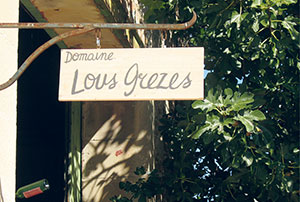
Domaine Lous Grezes, part of Les Vins S.A.I.N.S. (see Where and When: Grower Associations, pages 120–21), makes a range of sulfite-free reds.
Domaine Lucy Margaux, Monomeith
Adelaide Hills, Australia
Pinot noir
Dark cherry | Ginger | Blood-orange rind
South African Anton van Klopper started his career as a chef before turning winemaker. In 2002, after vintages abroad, Anton and his wife bought a 16-acre (6.5-hectare) cherry farm in the Adelaide Hills, and never looked back. Then, in 2010, Anton, along with friends Sam Hughes, Tom Shobbrook (see previous page), and James Erskine, created the Natural Selection Theory, a wine movement that, as Anton describes it, “is like free-flow jazz, outrageous winemaking with no beat of security, only an endeavor to push the boundary of wine beyond its stale present.” Today, Anton makes some of Australia’s purest pinot noirs. Always incredibly expressive, screaming wild-berry flavors, they are also spicy and savory. This cuvée uses fruit from a sunny 8-acre (3-hectare) site that is cared for by Patrick Sullivan, who also makes a gorgeous range of natural wines (look out for Haggis, if you fancy a taste of something different).
*No added sulfites from the 2016 vintage onward
Old World Winery, Luminous
California, USA
Abouriou
Mulberry | Malizia cherry | Rooibos tea
Darek Trowbridge, owner and winemaker of Old World Winery, is a museum curator of sorts, into whose care has been placed the last remaining plot of abouriou vines in California. “I am upholding the planting history and tradition of my family, as well as the curiosity of this heirloom variety,” says Darek, who has been working these 80-year-old vines on his folks’ estate in the Russian River Valley since 2008. Born into an established Sonoma grape-growing family of Italian ancestry, Darek learned “Old-World-style” winemaking from his grandpa, Lino Martinelli. Luminous lives up to its name, thanks to its note of bright cherry. (Also look out for Darek’s homemade prickly-pear ice cream, which he sells at the cellar door!)
*No added sulfites
Clos Saron, Home Vineyard
Sierra Foothills, California, USA
Pinot noir
Sweet pomegranate | Mulberry | Blonde coffee
Having arrived in the back of beyond with fellow members of a spiritual group, Gideon Beinstock eventually went solo with his own farm and vineyard, Clos Saron, named after his wife. “Saron, my inspiration, has many years of experience in viticulture,” says Gideon, “and a magic touch with all living things: dogs, cats, chickens, rabbits, bees, even little human kids.” Gideon has farmed using the lunar cycle ever since he noticed that the movement of lees he was caring for in a glass-sided barrel seemed to correlate with particular points of the month.
Produced in tiny quantities (just 852 bottles, in fact), this 2010 reminded me of Gideon himself, a man who doesn’t speak just for the hell of speaking. The Home Vineyard does not gush either—you have to make the first move, but then you’re rewarded with lots of hidden personality. A wine with floral prettiness and a great skeleton, it is tight and restrained, and more than a little reserved.
*No added sulfites
Santa Cruz Mountains, California, USA
Cabernet franc
Crunchy plum | Wisteria | Raspberry leaf
The last time I was in San Francisco, I met up with DC Looney from Punchdown (a great natural-wine hangout in Oakland), and walked away with a bottle of this fab wine. I cracked it open the very same day on landing back in the U.K.—so much for natural wine not traveling. Methode Sauvage believe that the idea behind their project is “to find a voice for Californian cabernet franc and chenin blanc from all over the state,” and find its voice they certainly have. It sings. A great wine.
*No added sulfites
Montebruno, Pinot Noir, Eola-Amity Hills
Oregon, USA
Pinot noir
Wild raspberry | Lily | Stony
Joseph Pedicini grew up in the New York area and, in the early 1990s, set off on a career in the micro-brewing industry, which was in its infancy at the time. By chance, work took him to Oregon, where he drank so much pinot noir that, pretty soon, beer was out and wine was in. “I grew up in a family of folks that emigrated here from Italy—one grandmother from Bari and the other from outside Naples—so were making wine at home, ever since I was a little kid. My grandmother and my father were huge influences on me as far as teaching me fermentation skills, gardening skills, and growing skills for that matter.” And, given what Joseph is producing today, I am sure Nonno and Nonna must be very proud. This pinot, growing on a particularly cool spot, thanks to a Pacific Ocean breeze, is fragrant, pure, and awesome.
*Low levels of sulfites added
 NEW WORLD FULL-BODIED REDS
NEW WORLD FULL-BODIED REDS
Castagna, Genesis
Beechworth, Australia
Syrah
Blackberry | Violet | Star anise
Located just over 3 miles (5km) outside the historic Victorian town of Beechworth, Castagna’s vineyards grow 1,600ft (500m) above sea level, up in the foothills of the Australian Alps. Owned by film director Julian Castagna and his film producer/writer wife, Carolann, the farm was designed along permaculture lines (see The Vineyard: Natural Farming, pages 32–37) in order to, in their words, “maximize the use of the land, while minimizing our impact on it.” To do this, they turned to David Holmgren (one of the Permaculture Movement’s founders), who helped identify key native trees, water-collection points, and the like, which all informed the final layout, and also advised on the building of a straw-bale winery. More than 15 years later, Castagna is today a much-celebrated producer, growing wines that are as alive as their farm and always showing great finesse.
*Low levels of sulfites added
Tony Coturri, Zinfandel
Sonoma Valley, USA
Zinfandel
Dark cherry | Crème brulée | Clove
A trailblazer, and often misunderstood, Tony Coturri is Mr. Zinfandel and a grower-cum-maker of very traditional Californian zins. Tony’s wines are in no way timid, but, being wonderfully balanced, they express a fascinating California that has sort of fallen off the map. Neither a large, branded wine, nor a trendy, pseudo-European one, Tony’s wine is heart-and-soul, proper California. Vastly under-rated, savory, and complex, no United States natural wine bar, store, or listing worth its salt should ignore Tony, his wines, or what he means for America.
*No added sulfites
Bodegas El Viejo Almacén de Sauzal, Huaso de Sauzal
Maule Valley, Chile
País
Red currant | Black fig | Smoky
Born of very old, ungrafted vines in central Chile, some dating back to 1650, this país—see Clos Ouvert, page 193 for more information on the recent renaissance of this grape variety—encapsulates traditional Chile. Farmed without irrigation, using techniques that, according to Renán Cancino (the grower-maker), were inherited from the Spanish conquistadors, El Viejo Almacén plows its vineyards by horse and eschews all synthetic fertilizers, agrochemical pesticides, or fossil fuels. Even vinification is traditional—using open-top, oak fermenters and old oak barrels, where the wines remain for a year before bottling. They then wait another year before being released. Bottling and labeling is done by hand.
Sauzal itself was settled back in 1789 by aristocratic families, who owned most of the land surrounding the town. As Renán explains, “My paternal grandmother was a nanny to one of the[se] aristocratic families. She was a single mother with one daughter, Julia, and one son, Bolivar, my father. She later dedicated her time to sewing back home, to raise her children, and was finally able to open her own store (Almacén), where she became a seamstress in 1960. My father followed in her footsteps and worked in the Almacén until the 2010 earthquake that destroyed most of Sauzal.”
*No added sulfites
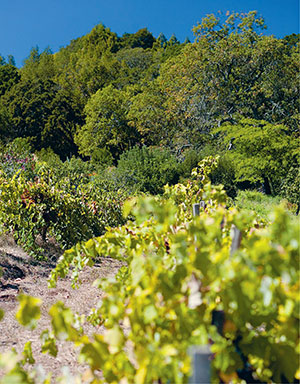
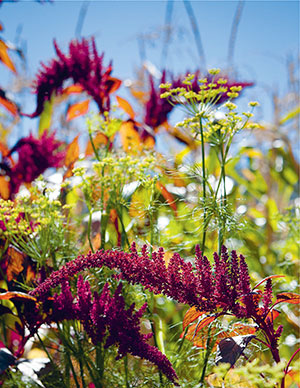
Tony Coturri’s vineyard and grapes in late summer. (See previous page for more information.)